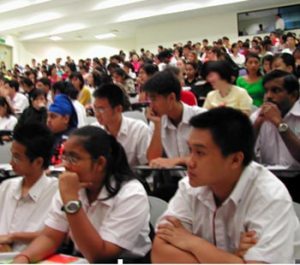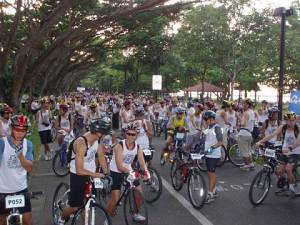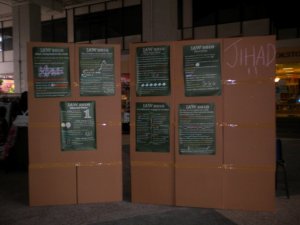Woe Cup 2010

By Ron Chua
Leon Lu could find himself missing out on the biggest sporting event of the year. He joins many other Singaporean football fans facing the bleak prospect of not being able to catch any World Cup action when it kicks off in South Africa this June.
209 countries have already secured the rights to broadcast the epic event that begins on Jun. 11, but Singapore is not one of them. With less than 70 days left to the opening match, football fans in Singapore will be left high and dry. Even though the football governing body, FIFA, has made the opening game, semi-finals and finals free-to-air, Singaporean fans are still less than cheered.
Lu and his fellow football fans are not the only ones affected. Businesses are also sweating over the impasse.
One of them is St. James Holdings that owns a number of bars in Singapore. Chief executive officer, Dennis Foo said, “(The World Cup) is once every four years and the climax of football. Without the live broadcasts, our business will be 50 per cent down but with it, we will be 50 per cent up.”
Advertising agencies are also feeling the pinch. With less than three months before the kick-off, analysts say advertising deals are getting harder to score. Victor Ng, chief creative officer at advertising agency Euro RSCG Singapore said, “Advertising campaigns that capitalise on the World Cup are highly time-sensitive.”
Regardless, some companies are continuing with their publicity plans. A spokesman for Coca-Cola said, “It’s full steam ahead; we absolutely believe in it and we’re not shying away from promotions just because the airing might be limited.”
Many are unhappy with SingTel’s and StarHub’s failure to negotiate a deal with FIFA’s regional sales agent, Football Media Services. The deadlock began after SingTel had won the exclusive rights to broadcast the English Premier League for the next three seasons.
According to an industry source, FIFA is asking for close to $100 million in broadcasting rights for the upcoming World Cup. This is up from the $10 million and $15 million StarHub paid in 2002 and 2006 respectively to broadcast the same event.
The source said, “Last year, FIFA quoted a price to both telcos, which was already a few times more than what StarHub paid for the 2006 World Cup.”
“After SingTel won the EPL rights, FIFA came back with an even higher amount,” the source added.
Several reports quoted that SingTel won the English Premier League broadcasting rights with a bid of $400 million. However, SingTel Pay-TV vice-president, Tim Carmichael, has come out and clarified that their bid “was less than the quoted amount.”
With the clock ticking, fans like Lu are desperate in their frustration. The second year student at the Nanyang Technological University said, “This is ridiculous. Somalia, Ethopia and us do not have the broadcast rights.”
Similarly, full-time national serviceman Lionel Lin said, “We can afford the EPL for three seasons but we cannot afford one month of World Cup.”
But there are others who feel that the companies should not give in to their demands. The escalating price of watching sports on cable television has many Singaporeans pessimistic that the eventual costs will be passed on to consumers.
The question now is, how much are fans willing to pay to watch the World Cup’s 60 matches in June? From $8.40 a month in 2004, fans now pay $26.75 just for StarHub’s sports package.
Taxi driver, Peter Chua said, “I will not pay unreasonable amounts to watch the World Cup. I might as well go to JB and watch.”
53 year-old Linda See had similar sentiments. She said, “If we give in this time, they will come back with a higher price in 2014.”
Being able to catch the semi-finals and final is good enough for Lee Shirley, a fan of football legend Cristiano Ronaldo. The third year student from the Singapore Management University said, “It will be best if Portugal wins the World Cup.”
Still, sports buff Cris Tan believes that SingTel or StarHub should secure the rights at all costs. The 27-year-old public relations practitioner said, “It comes only once in four years. I cannot wait eight years to watch the next World Cup.
For football-crazy Singapore fans, it is not over till the final whistle blows. “I might just install an antenna and tap into signals from Malaysia or Indonesia,” Tan added.
Owe Money Pay Money
By Clara Huang
He has a house he does not dare return to. For the past few weeks, the door of his flat in Tampines has been splashed with paint and locked with a steel chain. Samuel, who asked to be identified only by his first name, had chalked up huge debts after taking out a loan for his new business venture.
“My business is doing badly and I can’t repay. Then the boys wrecked havoc right away,” he said, referring to the loansharks who caused his family to seek refuge at a relative’s house.
Despite the relatively low crime rate in Singapore, the city-state has been plagued by a surge in loanshark-related violence in public housing estates. According to Ng Boon Gay, director with the Criminal Investigation Department, said that there was a 58 per cent increase from the previous year. There about 18,600 cases of illegal loans made by loansharks in 2009 alone.
According to the Singapore Police Force, one in five of those arrested for loan sharking and intimidation last year was aged 19 or under, compared with just one in 10 in the first half of 2008.
Loansharks lend money at exorbitant interest rates to those whose credit ratings are too poor to borrow from banks, drawing them with the promise of quick cash and fast approval rates.
These unlicensed money lenders then recruit runners to assist them in harassing the debtors who default on repayment. While some of the runners are lured to these nefarious activities to earn easy money for deceptively simple work, others do so to pay off their debts.
Tan Wei Boon, a former debtor of the illicit loansharks who almost caused his family to break up, said, “They gave me an option to repay back.”
He also said they asked him “to join them to be their runner. But I refused because it’s illegal.”
In fact, some loansharks have even made innocent neighboring households the target of threats, hoping that the pressure would force the debtors to repay their debts.
34-year-old Lim Yi Qi is among the residents who are upset that the peace of her neighborhood is disrupted.
“They broke my flower pots outside my house. My family and I are innocent and I’m really worried for my family’s safety, especially my daughter,” Lim said.
“Police should also hold borrowers accountable as their reckless borrowing and gambling habits endanger our community,” Lim added, expressing her displeasure towards irresponsible gambling addicts who have sought out loansharks to clear their debts.
While some of the borrowers are gambling addicts, government officials empathize with those who are faced with unplanned or short-term financial squeeze. At the Ministry of Home Affairs, officials announced in January that it is a criminal offence for errant debtors to borrow from unlicensed moneylenders.
Nevertheless, it is not possible to fully anticipate what new tactics the loansharks will adopt. In fact, loansharking and related harassment look set to become a greater threat to the citizens’ safety, as the Internet will allow them to perpetrate their crimes under the shroud of anonymity.
“I was told to transfer money electronically to them. Nowadays they’re more efficient than I thought,” said Samuel, recalling the first time the loan was made.
Law enforcement officers are doing their best to detect and punish all those who are involved in loansharking. The Ministry of Home Affairs is confident that the loanshark scourge can be tackled efficiently with the implementation of the new Moneylenders (Amendment) Bill in January this year.
The ministry will toughen the penalties for those carrying out loan sharking as well as those who assist the gangs. Still, unlicensed moneylending and loanshark harassment cases are not easy to solve, as there is still demand for them.
Frustrated by the thorny episode, Samuel urged people to understand the ramifications of borrowing from loansharks in spite of the easy way out.
“They should keep in mind that owing loanshark money not only causes mental and emotional strain to them, but also affect their family and loved ones as well,” he said.
Sharing the same sentiments, Tan regretted his decision to borrow from loansharks as he recounted on the turning point in his life although he has repaid his debts two months ago.
“The state should do more to help those in need of temporary financial assistance, such as slacken the bank loan policies for people like us to tight over this temporary financial burden,” Tan said.
Students Hard at Work
By Gloria Lee
Singapore Polytechnic student Kevin Tan, 22, finishes school before 3p.m., but gets home in the wee hours every day. As a result, he finds it hard to wake up in time for early morning lessons.
A freelance sound technician in charge of setting up sound systems for concerts and functions, Tan usually ends work after 2a.m. He is often misunderstood by his tutors who think he is out gallivanting. It is surprising that they do not show more understanding when he explains his situation.
“My teachers always haul me over the coals when my grades drop, blaming it on my work even though it’s not the case. Some even asked me to apply for financial aid so that I can stop working. But I like my job, and this is the industry that I eventually want to settle down in,” said Tan.
Initially, his mother was not supportive of the idea of him working while studying. But she came to accept it after she observed how he became more streetwise and responsible since working.
This is a scenario that many tertiary students will find familiar. It is common belief that students work because of financial problems. However, some students work during their vacation or even during term time for extra money to spend or to plump up their resume for enhanced employment prospects.
This rising phenomenon is boosted by the adoption of flexible work schemes by employers that are “especially suitable for students or adults pursuing further study”, as retired NTUC Income chief executive officer Tan Kin Lian noted on his blog.
Educators however appear divided over this new trend.
“If their families don’t need the extra money, they should not work part-time because it takes up their time and energy. School life is already busy and stressful enough without that extra load,” said Geraint Wong, a teacher at the School of Science and Technology.
Andrew Ng, programme executive for student life and services at the Singapore Institute of Management, disagrees.
“Many SIM students juggle work and studies. I think it’s good training because it will be something they have to do when they start work soon. It teaches them to manage their priorities well,” Ng said.
In a speech to Parliament last month, Senior Parliamentary Secretary for Manpower and Health, Hawazi Daipi, reiterated the government’s support of flexible workplaces. He noted that “employers in Singapore increasingly recognize the value of flexible work arrangements in attracting and retaining employees.”
Victor Lee, managing director for Vohringer Singapore, agrees. “Our corporate policy is not to hire part-timers. However, we have been looking at hiring students for freelance jobs, because it complements the skill sets of our permanent workers,” Lee said.
According to the Ministry of Manpower’s Employment Act, those who work fewer than 35 hours a week are considered part-time workers. Some students are coping so well that they even take it a step higher by entering the workforce proper.
This trend seems set to continue, as work and study programmes such as the National University of Singapore Overseas Colleges are gaining popularity with tertiary students, with a record sign up in its recruitment this year.
Starbucks store manager, Joan Lim, 24, has been with the café since she was 16. At the time, she was a full-time student working part-time. When she proceeded for further studies, she decided to switch to full-time work and part-time studies. The Tourism Institute of Australia graduate believes her decision has molded her into a stronger person, even as she admits it was not an easy path.
“You need determination and perseverance every step of the way, along with the ability to prioritize. You also have to forego your social life. But I have grown so much that if I had to choose again, I know I would do the same thing,” Lim said.
The economy today is a very challenging one, and it is not surprising that some students are proactively looking for part-time jobs because of post-graduation career concerns. It is not easy, but a good way to get ahead.
Benjamin Ng, 24, certainly thinks so. A full-time sales executive with a construction firm, he is enrolled in a part-time degree course in Murdoch University. Ng said, “This is the best way in which you can gain working experience as well as paper qualifications at the same time, while getting a pay check every month.”
This trend seems set to continue, as work and study programmes such as the National University of Singapore Overseas Colleges are gaining popularity with tertiary students, with a record sign up in its recruitment drive this year.
21-year-old Evelyn Lim, an undergraduate from that National University of Singapore School of Business, is among those who have successfully applied for the programme.
“I chose to come to [the National University of Singapore] mainly because I wanted to take part in this programme. I am sure it will broaden my horizons and make me more successful in my future career,” she said.
Power to the People
By Nadya Huang
There is no doubt that there are many power-hungry students in the National University of Singapore. Ang Zhi Wei, a 23-year-old political science major at the university, carries his multi-plug adapter to school every day so that he can pore over his work on the laptop. Yet, he finds it difficult to even secure a seat in the library next to a power socket.
It is a common sight to see students overloading power sockets in the library with extensions and multi-plug adapters. A quick check at the university’s Central Library on a typical Wednesday afternoon will attest to that.
Although the library has over 400 power sockets available for students to use, it seems that students still find there is a shortage.
“There are really not enough power points in the Central Library,” Ang said, “You either come real early or bring a multi-plug adaptor so you can get a seat beside a power socket to do work.”
Some students also use the power sockets to charge other gadgets such as their mobile phones. These habits contribute to the Central Library’s power bill of more than $96,000 a month. The management is aware of the situation, and has taken measures to cut down power consumption in other areas to offset the high electricity bills. However, there are problems impeding these solutions.
“We try to increase the temperature of the air-conditioning in the library but certain things like books and microfilms need to be kept at a lower temperature to maintain their condition,” said Patrick Lye, principal librarian of the university’s libraries.
“We are in an old building, and the electrical infrastructure might not be able to handle it,” he said, “but we are aware of the shortages and have contacted the Office of Estate Development to find a solution.”
Students are increasingly more dependent on their mobile gadgets. They spend long hours on their laptops trying to complete their work.
While some students are less conscious about their power usage, others have been actively trying to adopt good energy habits and encouraging others to do the same.
This group of students is from NUSSU Save, a student organisation devoted to fighting climate change. In conjunction with the World Earth Hour on March 27, they organized the Earth Hour event in the university.
During the event, students folded paper lilies out of waste paper as a symbol of hope for a better tomorrow. The 2668 paper lilies collected were used to create a tree-shaped mosaic at the Sports and Recreation Centre field. The display was lighted up with light sticks as a tribute to Mother Earth. This was recorded as the largest display of paper lilies in Singapore.
At 8.30pm on the day of the event, several non-essential lights on campus were turned off. The organizers had successfully managed to convince the administration to turn off more lights this year compared to last year’s Earth Hour.
These included lights from the various faculty buildings, six halls of residences as well as facility buildings in University Hall, Yusof Ishak House and the Sports and Recreation Centre.
23-year-old Calvin Tan is the Chairperson of NUSSU Save. The second-year Life Sciences student acknowledged that Earth Hour was more of a publicity event to raise awareness.
“The event itself does not do much for the environment, but is more of a symbolic gesture directed at individuals. We did get more than 2,000 different individuals to fold paper lilies and that is 2,000 people who can help to spread the message,” said Tan.
And they are not alone in their bid to save power and cut down consumption. The university’s Office of Estate and Development and Office of Environmental Sustainability work together in several projects to reduce electrical consumption.
These projects include the replacement of conventional lamps with energy-saving lights and installation of infra-motion sensors in newly renovated toilets. The office also intends to monitor trends in excessive electrical usage on campus so that they can implement measures to prevent wastage.
With so many initiatives to cut down on energy usage, there is definitely power to the people.
City Harvest Church: New Co-owners of Suntec Singapore
By Ron Chua
City Harvest Church has paid $310 million to be the co-owner of Suntec Singapore. This purchase was disclosed by senior pastor and founder Dr. Kong Hee during the Mar. 6 service at the Singapore Expo.
Reading from a legal statement, Dr. Kong said, “City Harvest Church has acquired a substantial stake in a consortium company that owns 80 per cent of the JV (joint-venture) fund that holds Suntec Singapore.”
Dr. Kong first told his congregation six weeks before that the church had acquired a prime piece of downtown real estate land for their new building. However, he could not reveal the exact details then due to non-disclosure agreements.
City Harvest Church revealed that 25 other plots of land were considered but 19 were unsuitable and six unsuccessful. In choosing the land, Dr. Kong said that the main consideration was it had to be “able to house 12-15,000 people”, “be centrally located and easily accessible via public transport” and “have facilities for everyone”. He added that Suntec Singapore is also near its corporate office at Suntec Tower Three, and its co-office at Riverwalk.
The sum of $310 million includes rental costs, renovation costs and the cost of share acquisition in the consortium.
The Suntec Singapore International Convention and Exhibition Centre has 78 years left in its lease. As co-owners, City Harvest Church will have exclusive use of levels six and seven, where the convention hall is located. Levels four and five, which are regularly used for exhibitions and conferences, will continue to be available for public lease.
The church will carry out all its services in this new location as well as its current building at Jurong West. They will move in on Mar. 2011 when their current contract with Singapore Expo expires.
Churchgoers were excited upon this new revelation. Cindy Chung, a student from the National University of Singapore, said, “Finally we can go to church and shop and eat all in one place.”
Others were delighted with the location. 56-year-old retiree Peter Lee, who stays in Clementi, said, “This is great. Going to Suntec for service will cut my travelling time by almost half.”
Coinciding with the announcement was the launch of the Arise & Build campaign, which aims to raise $17.3 million over the next four months to fund the fifth installment in a series of 13.
Citing a confidentiality agreement, City Harvest Church could not reveal the full details of how the $310 million would be spent, nor the number and price of the shares the church had bought.
However, “all material details” have been disclosed to the Commissioner of Charities and the Urban Redevelopment Authority.
Cyclists challenge longest biking route in Singapore
By Gloria Lee
As Singapore gets set to host the Youth Olympic Games in August, cyclists here geared up for a challenging race of their own – one that holds the record as the longest round island cycling route in Singapore.
A major national event organized annually by the Nanyang Technological University Sports Club, the Bike Rally 2010 offered participants the choice of the regular 128-kilometre route or an extended 168-kilometre route for endurance cyclists.
In landlocked Singapore, the extended route was warmly welcomed by the burgeoning cycling community. In fact, registration had to be closed early due to overwhelming responses.
“This is by far the longest cycling distance offered in Singapore, and we pride ourselves on being able to offer this unique feature,” said Colin Kwek, chairperson of the organizing committee.
The organizers had to limit the number of participants due to safety and operational concerns. A total of 673 avid and leisure cyclists turned up for the event. Among the participating cyclists were two former members of the Singapore Paralympics contingent.
The Guest-of-Honour for the event was Hri Kumar Nair, member of parliament for Bishan-Toa Payoh GRC. A cycling enthusiast himself, Nair noted that cycling as a sport had recently picked up local momentum, especially since Tampines New Town opened up its footways to cyclists in December last year.
Cyclists engaged a route that started and ended at East Coast Park, with six checkpoints in between. Cyclists had to negotiate terrain in both the city and heartlands of Singapore, passing by famous landmarks such as the Esplanade and the Singapore Flyer.
Citing safety considerations and physical ability, the organizing committee determined the minimum requirement for participation to be 17 years of age. As the Bike Rally was originally organized to promote cycling as a healthy way of living, participants came from all age groups. In fact, the oldest participant was 64 years old.
A 17-year-old student from Temasek Polytechnic, Teh Jin Yu, was inspired to join the event because of the attractive lucky draw prizes that included hybrid bicycles, Nike products and Crumpler bags.
“I initially signed up because the prizes were good. But the experience turned out to be a fantastic one,” said Teh, who finished the race in eight hours.
The non-competitive race flagged off at 7:00 a.m., and the average cyclist took about seven hours to complete the race. The first cyclist came in at 1:30 p.m. while the last cyclist crossed the finishing point at 7:00 p.m.
NUS Students Clear Up the Struggle Within
By Nadya Huang
In an bid to correct the slant in which mainstream media has framed the concept of ‘Jihad’, the National University of Singapore’s Muslim society organised the Islamic Awareness Week 2010.
Themed “Embracing Jihad: the Struggle Within”, the event was held in the National University of Singapore on Feb. 22.
One of the organizers, Sofia Jasmani, said, “People will only remember the war and killings from the news, but Jihad simply means ‘a struggle within’. We practice it in our everyday lives like if we have difficulty in our homework or chores. That’s a struggle within too.”
The student organizers started the project to foster better public understanding of Islam. To the students, it is an important event as it is one of few that reaches out to beyond the Muslim community.
“We want to help people to differentiate the teachings of Islam and being Muslim from the picture that has been formed in the media,” said Jasmani.
Leonard Tham, a third year Economics student from the Faculty of Arts and Social Sciences, said, “I think it is important for people to understand Islam, especially with the recent burning of several churches in Malaysia.”
The week-long event had many different activities to engage the public. Jasmani said, “We wanted to choose different, more engaging programmes other than just talks to attract the audience.”
This included a debate on Monday evening about “Terrorism: Is Islam Against it?” Two students took opposing stands to debate the issue in front of an audience of 60, some of whom are from other universities such as the Nanyang Technological University and the Singapore Management University.
An interactive exhibition was held at the Central Library foyer, with posters explaining Islamic concepts such as ‘jihad’ and ‘halal’.
The response to the event has been positive, according to Jasmani.
She said, “People have been reading our posters and joining in the activities we have organized. They’re asking us questions to clarify their doubts.”
Tan Ju Ling, a fourth year student who was at the exhibit said, “I think the exhibition in the library foyer has been good – very interesting and informational.”
“The week has been a success so far in the sense we managed to reach our target audience, but we know we can only really reach people who are interested to know more,” said Jasmani.
Big Losses Make a Winner
By Nadya Huang
Asia’s first Biggest Loser is David Gurnani, who produced staggering numbers in the finale to trump three other finalists.
The 25-year-old Indonesian shed 83 kilograms off his original frame in six months. His sum of weight and fat loss at 53 per cent and 45 per cent respectively gave Gurnani his victorious 98-point score during the finale on Mar. 9, in Kuala Lumpur, Malaysia.
The finale video showed how each of the four finalists prepared for the final weigh-in after graduating from the show’s 13-week long boot camp.
In contrast to the other contestants who had resumed their regular lives, Gurnani had chosen to continue a similarly – if not more – rigorous routine as that during boot camp.
Foo Peiwen, a second-year Japanese Studies major at the National University of Singapore, was impressed with Gurnani’s achievement.
She said, “I think it’s quite inspiring to people who have had similar problems; they can follow by example and shed the weight with exercise and a good diet.”
However, many others carry reservations. 54-year-old Wong Fook Nyen is among them.
“It’s ridiculous to lose so much weight in five or six months. At first when you look at him you think he’s skinny, but his face looks so haggard,” said Wong, who is a loyal fan of the show.
His opinion appears to be shared by many others on the internet. Shemah, a blogger, wrote, “I just can’t help but feel sorry for him because he looks so sickly. He looks really haggard. He’s only 25 years old and he looks scary ill.”
The forum on the official site has also been abuzz with such comments. One user, BoyStar, said, “He may have won but he sure made a mockery of the show contradicting the very purpose of the show.”
In the finale video, Gurnani said, “I exercise eight to ten hours a day,” adding that he kept to “the strict diet” and “had no trouble resisting temptation.”
However, in the post-show press conference, he said, “Eight to ten hours a day is extreme. I did that because it was part of a competition. I would suggest that eight to ten hours a week of exercise would be enough.”
Gurnani’s closest contender was 32 year-old Carlo Miguel from the Philippines, who lost 49 kg in six months to emerge as first runner-up.
Gurnani walked away with US$100,000 and a brand new Renault car.
Huge Turnout at Biggest Street Party in Singapore
By Clara Huang
The overwhelming 8,000 strong turnout at City Alive! 2010 turned Singapore’s largest street party into a dance and music extravaganza.
During the event, the 360-metre long F1 race track was used as a dance floor. This move drew more young street revelers to party their night away in front of the F1 Pit Building on Saturday, Feb. 20.
“It’s much more enjoyable this year as we have more standing room to dance our hearts out. I am already looking forward to the next year’s party,” said Calvin Liu, 23, a national serviceman, who always keeps a lookout for nightlife events in Singapore.
28-year-old Leong Jing Yun, one of the organisers of City Alive!, said, “The Hippo Open-Deck Bus is definitely the winning formula to draw people to come back again. In fact, DJs hyped up the crowd by spinning rapturous music on the Hippo Bus is unusual in Singapore street-part.”
Organised by the People’s Association and People’s Association Youth Movement, City Alive! was held at City Hall area for the last two years, in conjunction with the annual Chingay Parade.
“City Alive! took place for the third time in three consecutive years as it is certainly the ideal platform to engage more youths from diverse backgrounds to come together to enjoy themselves,” Leong added.
As the party lasts from dusk to dawn, access to the new party location was one of the concerns expressed by this year’s event organisers.
According to Leong, complimentary shuttle-bus services were catered for the public as the F1 pit building is not as accessible as City Hall.
Jacqueline Cheok, a fourth-year undergraduate at the National University of Singapore’s Faculty of Arts and Social Sciences, participated in City Alive! for the first time.
“I think the location is slightly out-of-the-way. But this shouldn’t be a problem for most people, with a bus-stop at Singapore Flyer and a car park nearby,” Cheok said.
Come next year, City Alive! will return with more exciting concepts and performances for the young energetic partygoers.
“We always believe there is a huge demand for outdoor party among the young,” Leong said.
Record sales at IT Show 2010
By Clara Huang
The four-day IT Show 2010 generated a record $67.5 million in sales over the weekend, an increase of $10 million over last year’s taking.
With more than 807,000 visitors, the show also recorded its highest turnout in its eight-year history.
Ho Wei Xuan, sales director of Starhub, said, “The crowd has been fantastic so far. It is a good sign that consumers are receptive in spending now since the economy is picking up.”
Regarded as the largest electronic fair in Singapore, the fair occupied five levels of Suntec Singapore. This exhibition space exceeded last year’s by 1,500 square feet.
The 820 exhibitors had reserved some of their best deals for this annual fair.
27-year-old marketing executive Huang Youde was one of the satisfied shoppers. He carted away a Fujitsu laptop and a free 19” LCD Monitor.
“The freebie makes this my best buy today. I believe the shops out there are not able to offer this attractive deal,” Huang said, referring to complimentary gifts offered by retailers.
In the exhibition halls, the aisles along the booths were flooded with people making enquiries and purchases of popular products such as high-definition televisions, laptops, digital cameras and printers.
Goh Wan Ling, a third-year NTU undergraduate, who visited the IT Show for the first time, said, “Singaporeans are surely very tempted by the special offers here.”
The showcase of cutting-edge technological innovations also drew many interested visitors. There were long queues at the Sony 3D pavilion to watch 3D-content screened on a 270-inch screen.
IT Show 2010 ran from Thursday to Sunday.
Just for Laughs Now in Asia
By Ron Chua
Since the cessation of broadcast operations by TVMobile early this year, disappointed viewers have been petitioning for the return of popular hidden-camera comedy show Just for Laughs Gags.
This accounted for the large crowd at the mobile road show organised by MediaCorp that marked the launch of the newly-minted Asian edition of Just for Laughs Gags and highlighted the first time the show was produced in Asia.
Held at the open space between ION Orchard and Ngee Ann City on Saturday, the event allowed the eager audience a preview of the candid scenes caught on local camera. Scenes such as a victim walking along Clarke Quay being ambushed by a group of screaming girls wanting his autograph had the audiences in fits of laughter.
Singapore had been chosen as the inaugural filming location and there are plans in the pipeline to produce the series in other Asian countries as well.
Just for Laughs Gags Asia crew member Eugene Lim, 18, said, “The public is very enthusiastic and many came to take pictures with us. They did not need prompting.I
Kevin Chum, marketing promoter for MediaCorp Channel 5, believes that Just for Laughs Gags Asia will be well-received as “it is a first for Asia and Singapore.”
To simulate the responses of unsuspecting subjects à la the popular hidden-camera comedy show, a creative photo moment contest was held in conjunction with the road show.
Ai Tong Primary School student Gerald Lim, 12, was one of the winners. A loyal follower of the series since Primary One, he had specially attended the event with his mother and sister.
“I am very happy and excited that Just for Laughs is in Singapore and I prefer Singapore’s version,” he said.
Fans who missed the road show can catch the crew at Raffles City or Vivo City today at 2.30 p.m. and 5 p.m. respectively.










